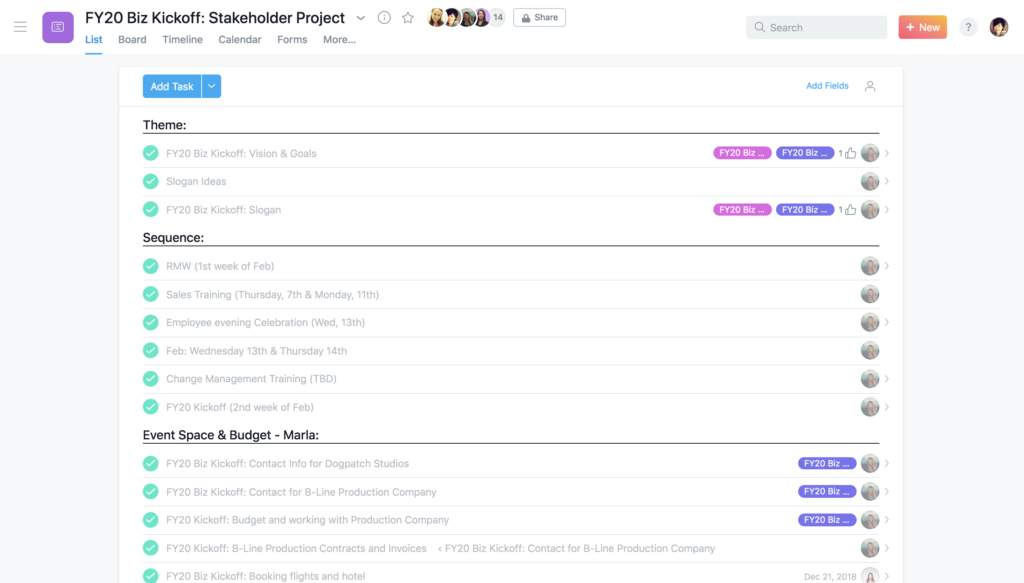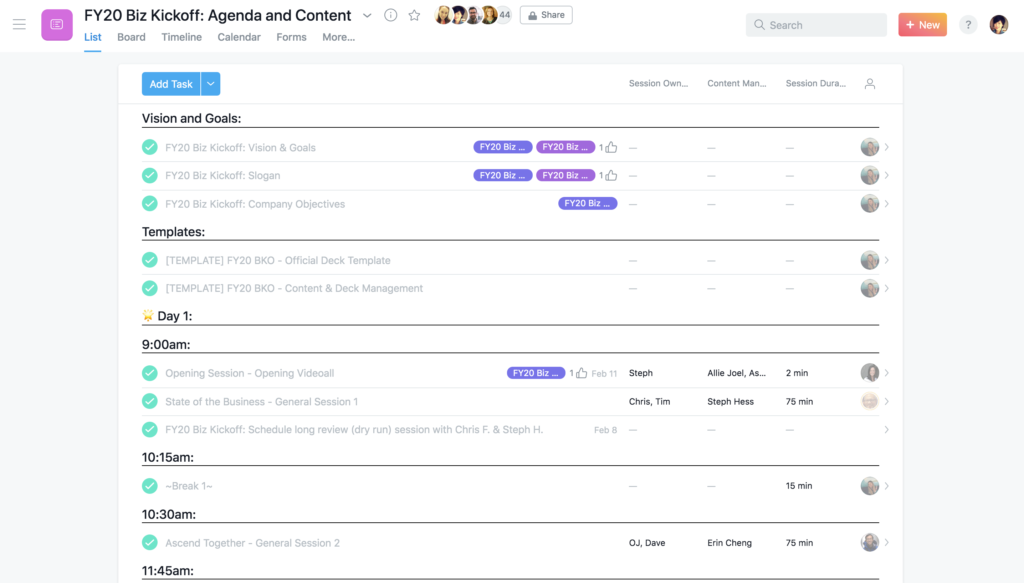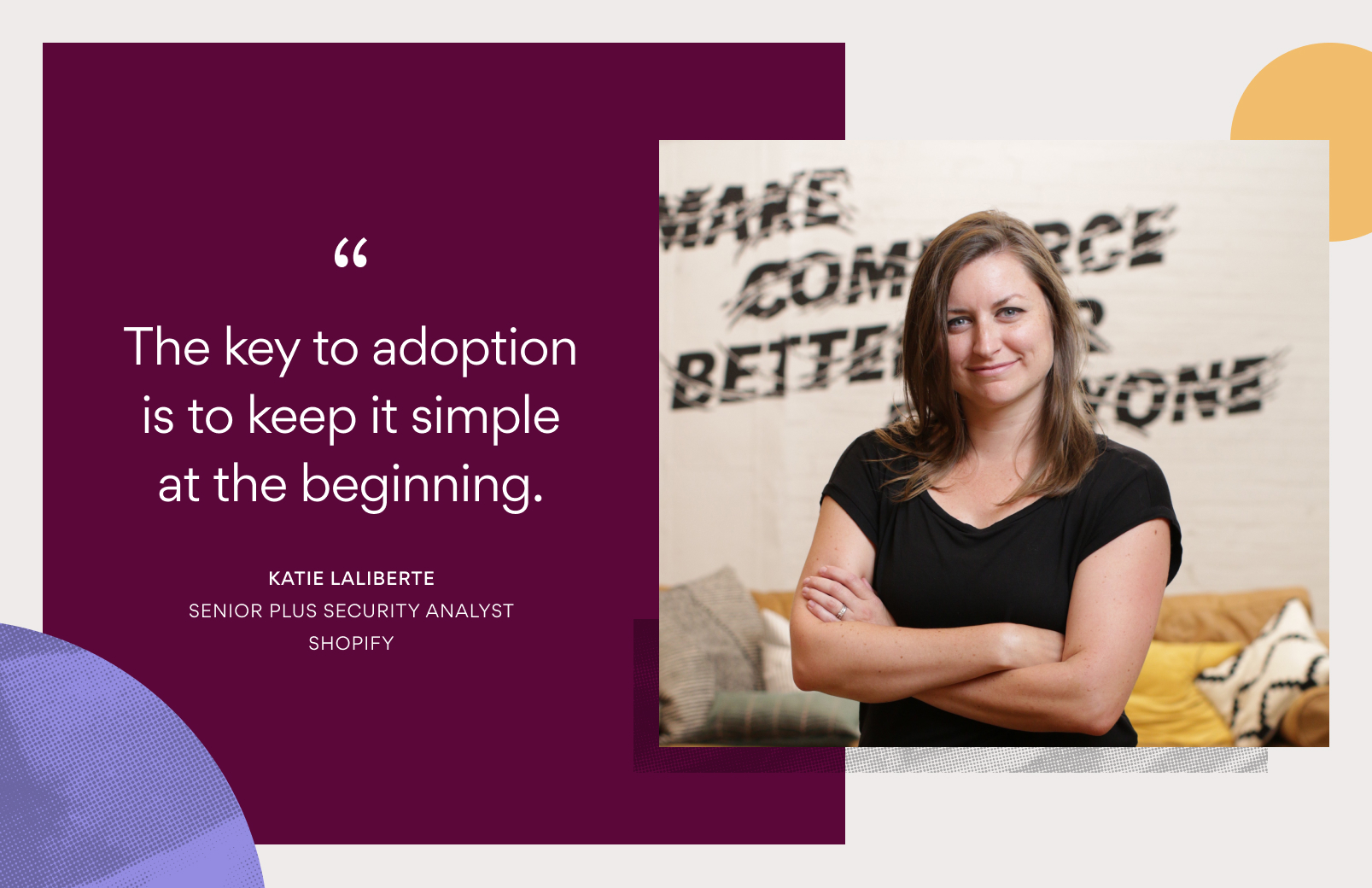How Asana uses Asana: Building a repeatable event planning process

I recently led Asana’s first annual business kickoff (BKO), a two-day global gathering featuring main stage keynotes, breakout sessions, customer panels, and streaming videos—anchored by a few surprises and delights for our employees.
As you can imagine, the task at hand had lots of moving parts with many internal and external stakeholders. How did I make sure that people knew what to prioritize, stay within our budget and timeline, and produce a flawless event? By using Asana, of course!
Whether you’re planning an event similar to the one described above—or a community event, internal all hands, or conference—Asana can help you orchestrate it all, while also giving you confidence that your event will be a raving success.
Why you need clarity when planning an event
Given the number of tools available to reach audiences, you might think live events are becoming a thing of the past. In fact, 84% of executives believe in-person events are a critical component of their company’s success.
Live events can captivate a targeted audience and deliver an engaging environment that lends itself to tell a story, share a vision, or show a solution. For these reasons, it’s important to have a smooth planning process that can be operationalized, standardized, and easily repeated. This gives your team clarity on your event goals as well as the ingredients needed to achieve them.
Putting clarity into practice with Asana
Because BKO was a multifaceted event, I found it helpful to create a few different projects and add them to a Portfolio in Asana to manage the entire process, from setting the strategy to day-of execution.
1. The stakeholder project: Aligning on the vision
The first project I created was the “FY20 Biz Kickoff: Stakeholder Project.” The main purpose of this project was to get clarification on the vision and goals of our leadership team. I added the relevant stakeholders to the project, and from there, we iterated on our theme, dates, location, budget, attendee list, content, and programming—all things critical to achieving the desired outcomes.
What was so great about this project was that it gave people the chance to provide input and make decisions asynchronously, without unnecessary status update meetings. Here are some ideas on how you can do the same:
- Create and assign tasks or subtasks to the appropriate owners and decision makers
- Share ideas and feedback using the comments feature on tasks
- Add additional (or remove) stakeholders as task followers as needed

2. The logistics project: Nailing the details
Once I had a clear direction on the look, feel, and flow of BKO, I was ready to bring the vision to life and dive into logistics. While I could have included these tasks in the stakeholder project, I created a different project called “FY20 Biz Kickoff: Asana Event Production” to help me organize the details separately. Here are a few tips for you and your team:
- Create project sections and categorize your tasks by theme. Use Board view for image-heavy tasks and decision making and List view to see what’s been done and what’s left to do.
- Add individual tasks to one or more projects for easy reference. The task information syncs across all projects and saves you the effort of duplicating or quality controlling the data. For example, I added the “Vision & Goals” task as a cornerstone to all my BKO projects.
- Invite external vendors to the project and assign or add them as followers to relevant tasks. This includes people from production, design, catering, and beyond.
Again, we were able to accomplish a lot through asynchronous communication, which was great for keeping things on track. Because event managers are often away from their desks and running from one thing to another, the team relied on the Asana mobile to check in, report on, and complete tasks regardless of location or time of day.

3. The event agenda and programming project: Creating the content
At this point, it was time to focus on the content and run of the event. While I could have managed this work in one of the other projects, I again created a separate project called “FY20 Biz Kickoff: Agenda and Content.”
I set this project up visually like an agenda. Each section represented a speaking or stage session, making it easy for presentation owners to see how the days flowed and how their content fit into overall programming. In each section, I provided additional context for event speakers, set proper expectations, and provided basic presentation guidelines. This included stage production, which involved everything from walk-on music and microphone preferences to submissions of presentation materials and rehearsals in front of a steering committee to guarantee a perfect delivery.
By keeping the conversations in this project limited to all things programming, speakers were able to focus on their presentations instead of getting distracted by the ideation and logistical noise of the other two projects.

4. The Portfolio: Managing it all in one place
Finally, I created a Portfolio to oversee all of my BKO projects. By housing everything in one Portfolio, I was able to monitor the status of each project in one single view and drill down to more detail where needed. This was the 360-degree view of the real-time information I needed to feel confident that the event was on track throughout the planning process.

A template for event success
So, how did our first-ever BKO go? 95% of survey respondents said it was “Very good” to “Excellent.” I’m confident this was because we had clarity throughout the planning process, thanks to Asana.
The best part? Because we’ve built out tasks, projects, and a portfolio to plan the event, we now have an operationalized and standardized process that can be used by anyone on our marketing team. And when I’m ready to kick off our next BKO, I have a proven template to help me plan and manage everything, faster
Planning your next event? Get a head start with our event planning template.

